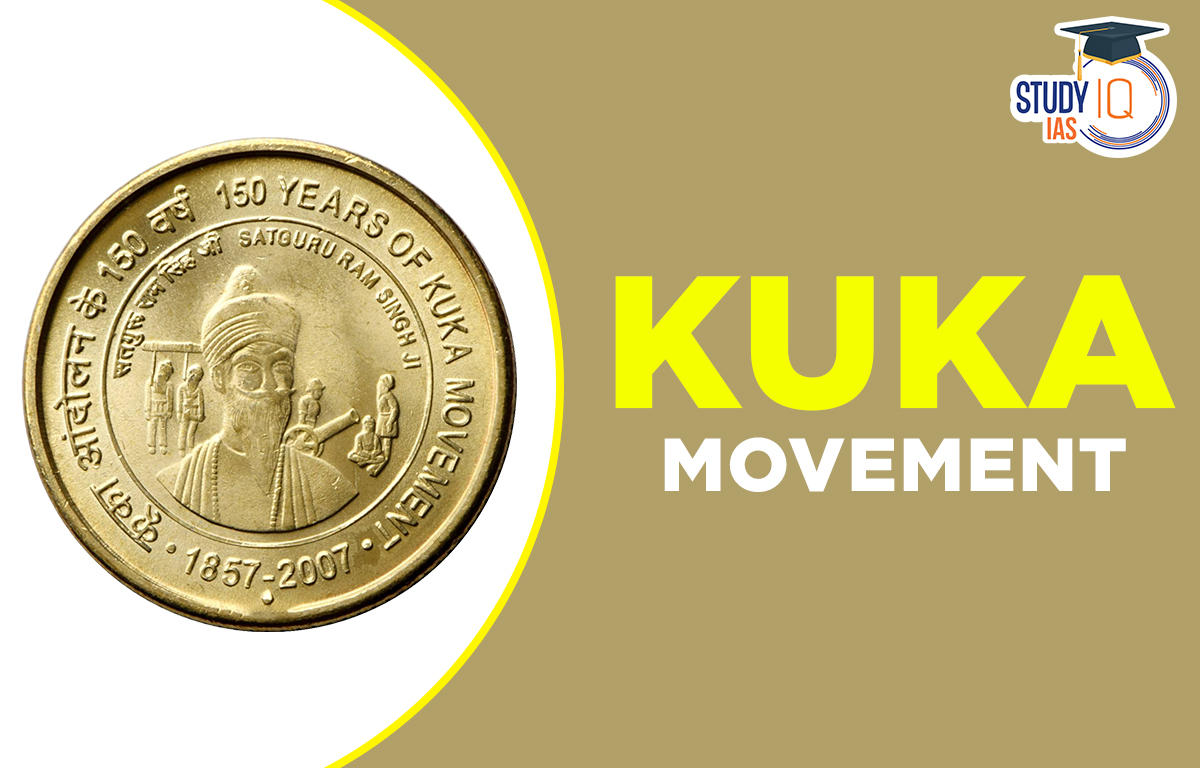Table of Contents
Kuka Movement
The Kuka Movement was led by the Kuka Sikhs, also known as the Namdhari Sikhs, under the leadership of Baba Ram Singh. The movement had social, religious, and political dimensions and aimed to reform Sikh society and resist British colonial rule. The first notable uprising in Punjab against the new British authority was the Kuka Movement. It was the Sikh community’s first significant response to the British Empire’s post-1849 new governmental system. This article contains all the information they need on the Kuka Movement for candidates preparing for the UPSC Exam.
Kuka Movement History
The early years of the Kuka Movement have a dubious background. The beginning of this movement is credited to two people: Baba Balak Singh and Bhagat Jawar Mal.
The Namdharis frequently became emotional while chanting Sikh Mantras or repeating the name; they screamed and shouted, held their turbans in the air, and let their hair stream in the process; this earned them the nickname “Kukas,” or the shouters. The name “Kuka” comes from the Punjabi word “kook,” which means to cry. The Namdharis can be recognized by their white clothing and distinctive headgear.
Kuka Movement Uprising
The Kukas held a convention in 1871 at the Ferozepur village of Khote. In spite of Ram Singh’s warnings, who was present at the conference, the Kukas split into two camps and started arguing with one another. Several Kukas lost control and attacked and killed numerous butchers and other people who were suspected of killing kine.
The butchers were then killed all over the area after this. The Kuka supporters were successful in enforcing civil disobedience and carrying out extreme acts, such as killing butchers opposed to cow slaughter. Numerous researchers believe that because the Kuka were iconoclasts, they attacked religious buildings. This offended the religious beliefs of people who practised other faiths. Also, the religious piety that served as their foundation was forgotten over time.
| Other Important Movements | |
| Aligarh Movement | Ahmadiyya Movement |
| Deoband Movement | Paika Rebellion |
| Tribal Movements in India | Ahom Revolt |
| Chuar Uprising |
Kol Rebellion |
Kuka Movement Founder
The son of a meagre carpenter, Baba Ram Singh was born in 1815 in the little town of Bhaini, some 7 kilometres from Ludhiana. He was a soldier in Prince Naunihal Singh’s Sikh Army in the early 1840s. After the Sikh regime was overthrown, he resigned from the army. He first met Baba Balak Singh in the year 1838, and he also kept in touch with Bhagat Jawar Mal.
Kuka Movement Objective
The first significant Punjabi backlash against the new political order put in place by the British came in the form of the Kuka Movement, led by Baba Ram Singh. The kukas lived by a set of principles, which they also preached. It is referred to as a religio-political movement since the Kuka Movement has two angels:
- Religious and
- Political.
Mahatma Gandhiji eventually accepted these beliefs and employed them once more against the British in the War of Independence. The Kuka Movement adopted a non-cooperation and civil disobedience policy against the British. Baba Ram Singh is regarded as having led the uprising despite the fact that Baba Jawar Mal and Baba Balak Singh are two names connected to the Kuka Movement. This is because he stepped forward and assumed leadership when Baba Jawar Mal passed away.
Kuka Movement and Government Action
Several Kukas were detained by the government, who then executed or imprisoned them. When some Kukas escaped Ram Singh’s authority and chose to attack and occupy Malerkotla in 1872, there was a severe outbreak. As a result of the government’s aggressive response, many of the Kuka ringleaders were destroyed by cannon fire.
Despite Ram Singh having told the authorities that certain bad actors had misappropriated his name, the administration came to the conclusion that Ram Singh’s true motivation and aim was to rule and amass dominion under the guise of religion. He was consequently apprehended and taken into exile in Burma. Later, he perished there.
Kuka Movement Outcomes
Guru Hari Singh was successful after Ram Singh. For twenty-one years, Guru Hari Singh was prohibited from leaving his home in the village of Bheni. He was succeeded by Pratap Singh after his death in 1906. The British government made an unsuccessful attempt to pacify the Kukas in 1914 by giving them land grants during World War I.
The Kukas launched their newspaper Satyug in 1920, followed by their daily Kuka in 1922. The Kukas freely joined hands when Gandhiji began the non-cooperation movement. According to legend, Gandhiji adapted his campaign to transform India’s social and political system after learning a lot from the Kukas.
Kuka Movement UPSC
Born in 1815 in the Punjabi village of Bhaini, Baba Ram Singh was the carpenter’s son. He had previously served in Prince Naunihal’s Sikh army, but once the Sikh regime was destroyed, he was discharged. Later, he interacted with Bhagat Jawar Mal and Baba Balak Singh. Ram Singh was imprisoned and banished in 1872, and the British army cannonballed 65 Kukas. The Kukas, also known as Namdharis, were a Sikhism-related cult. Under Ram Singh, they were formed as a group for religious purification.





















 WhatsApp
WhatsApp